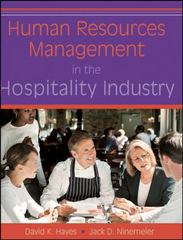Question
Research paper on Building and Structures Repurposing Technologies For the research paper, its required to find sources of information (at least 3) for the response.
Research paper on "Building and Structures Repurposing Technologies"
For the research paper, its required to find sources of information (at least 3) for the response. Organizational websites are good resources for "best practices" or "evidence-based leadership" in most cases. Find at least 3 peer-reviewed articles is required. Other good sources include Wall Street Journal, New York Times, Harvard Business Review, Academy of Management Perspectives, California Management Review, MIT Sloan Management Review, Business Week, Fortune, Forbes, Academy of Management Journal, Organization Science, Administrative Science Quarterly, Academy of Management Review, Management Science etc.
Choose one of the following topics for the paper:
Topic 1: Current Leadership Theories
Theories on leadership and management have been refined over time by different theorists. Effective management and leadership are required for businesses to achieve their goals and objectives. As we have read in our textbook, the traditional process of leadership deals with the planning, organizing, controlling, and leading. New research seeks to explain and understand the effects of leadership on practical outcomes such as performance. The goal for most theories is to help provide a basis for effective leadership so that organizations may produce and replicate the conditions under which this occurs.
Please choose one of the following contemporary theories in leadership and provide a summary of the theory and how it can lead to positive outcomes at work. Be sure to include your ideas and thoughts on how this could help your personal career as well as any personal experiences that you have had in your work life that relates to the theory. I have listed a peer-reviewed article for each one to get you started. You do not have to use the article I have posted; however, these are good examples of peer-reviewed journal articles.
Theories (Choose 1):
1. Authentic Leadership
Gill, C., Gardner, W., Claeys, J., & Vangronsvelt, K. (2018). Using theory on authentic leadership to build a strong human resource management system. Human Resource Management Review, 28(3), 304-318.
2. Spiritual Leadership
Fry, L. W. (2003). Toward a theory of spiritual leadership. The Leadership Quarterly, 14(6), 693- 727.
3. Adaptive Leadership
Yukl, G., & Mahsud, R. (2010). Why flexible and adaptive leadership is essential. Consulting Psychology Journal: Practice and Research, 62(2), 81-93.
4. Transformational Leadership
Farahnak, L. R., Ehrhart, M. G., Torres, E. M., & Aarons, G. A. (2020). The influence of transformational leadership and leader attitudes on subordinate attitudes and implementation success. Journal of Leadership & Organizational Studies, 27(1), 98-111.
Topic 2: Organizational Citizenship Behaviors (OCB)
Organizational citizenship behavior (OCB) refers to discretionary, nonrequired contributions by members to the organizations that employ them. The five most common organizational citizenship behaviors are: Altruism - Altruism in the workplace occurs when an employee helps or assists another employee without expecting anything in return. Courtesy - Courtesy is polite and considerate behavior towards other people, in this case, other employees. Sportsmanship - Put simply, sportsmanship is about an employee's ability to be a good loser. It's about being able to deal with situations that don't go as planned - or negative surprises - and to not demonstrate negative behavior when that happens. Conscientiousness - Conscientiousness is defined as behavior that involves a certain level of self-control and discipline and that goes beyond the minimum requirements. Civic virtue - Civic virtue is about how well someone represents the organization they work for. It's about how an employee supports their company when they're not in an official capacity.
Please provide a summary of this theory and how it can lead to positive outcomes at work. Be sure to include your ideas thoughts on how this could help your personal career as well as any personal experiences that you have had in your work life that relates to the theory. I have listed a peer-reviewed article to get you started.
Podsakoff, P. M., & MacKenzie, S. B. (1997). Impact of Organizational Citizenship Behavior on Organizational Performance: A Review and Suggestion for Future Research. Human Performance, 10(2), 133.
Topic 3: Motivation to Lead
Leadership is a complex phenomenon that is adaptable throughout various situations, groups of followers, and individual development. One important characteristic for leaders has been motivation (Chan & Drasgow, 2001). Motivation is the drive or determination an individual must have to achieve a goal. Chan and Drasgow (2001) developed a construct called motivation to lead (MTL), which describes an individual's motivation to become and succeed as a leader. As college students that are pursuing a degree in business (even if you are not, wherever you work is still a business), you may be motivated to achieve a leadership position for different reasons. Please provide a summary of this theory and the MTL construct (all three dimensions) and how it can lead to people choosing leadership roles. Be sure to include your ideas thoughts on how this could help your personal career as well as any personal experiences that you have had in your work life that relates to the theory. I have listed a peer-reviewed article to get you started.
Kim-Yin Chan, & Drasgow, F. (2001). Toward a Theory of Individual Differences and Leadership: Understanding the Motivation to Lead. Journal of Applied Psychology, 86(3), 481-498.
Step by Step Solution
There are 3 Steps involved in it
Step: 1

Get Instant Access to Expert-Tailored Solutions
See step-by-step solutions with expert insights and AI powered tools for academic success
Step: 2

Step: 3

Ace Your Homework with AI
Get the answers you need in no time with our AI-driven, step-by-step assistance
Get Started


